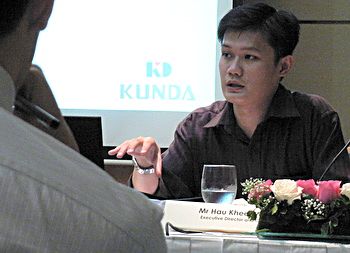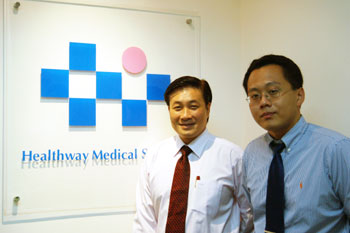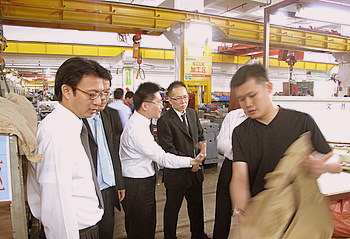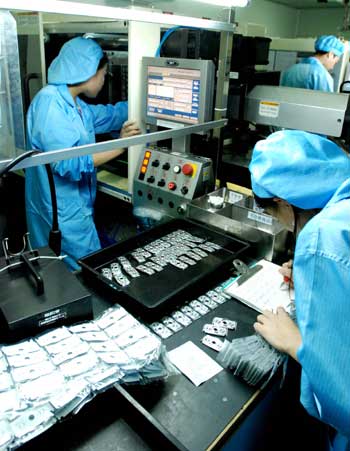
An In-Mould Design line at China Kunda's factory in Shenzhen.
THE WORST is over – and the best is yet to be for China Kunda.
Late last year, China Kunda’s customers deferred delivery of moulds they had ordered, and ran down their inventory.
But from February, China Kunda “has received fairly strong orders” for its moulds, said CFO Hau Khee Wee at a recent meeting with analysts to discuss the company’s financial results for FY09 (ended March 09).
Revenue for the company, which listed on the Singapore Exchange in October 2008 (IPO price: 21.5 cents), dipped 0.8% to HK$99.8 million.
Operating profit (excluding IPO expenses) fell 20.8% to HK$44.7 million.
Reflecting the pick-up in business from February, its mould order book stood at HK$42.2 million as of end-April.
Of that amount, HK$33.3 million were received between February and end-April. China Kunda completes its mould jobs usually between two and four months, said Mr Hau.
The best is yet to be for China Kunda not only as a result of a recovery in business but also because the underlying industry trend is favourable.
Currently, a large proportion of moulds and parts for automobiles assembled in China comes from overseas or are made in China by foreign-owned companies. (Auto moulds worth RMB 5-7 billion were imported annually by China in recent years).
The strong demand for foreign moulds springs from the fact that made-in-China moulds have yet to catch up in quality. But China Kunda has the technical expertise to offer high-quality but lower-cost moulds to car makers based not only in China but also the US and Europe. The latter two markets accounted for 51% of its sales in FY09.
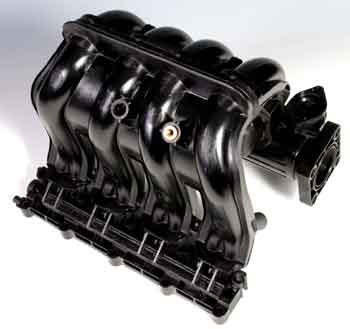
Plastic air intake manifold: Kunda provides the engineering expertise to come up with the mould for this automobile part.
Big $ in component manufacturing
Further down the road, China Kunda is mulling a strategy to capture a significant profit potential in component manufacturing.
The simple logic is: The company now makes a handsome profit (group gross profit margin was 34% last year; net margin was 38.6%) from each mould that it produces.
The profit is one-off, however.
The mould is then used by its customer to produce hundreds of thousands, if not millions, of parts. It could be for parts in cars (such as BMW, Audi and Mercedes-Benz) or electronic gadgets such as mobile phones and laptops.
The profit from each part is small for the manufacturer but it is multiplied many times over a period of time.
“We recognize the importance of this and the difference it could make to our company in the next two or three years,” said Mr Hau.
Foreign-owned companies are the ones which supply components to car assemblers in China, a dominance which traces its roots to the fact that while assemblers need to be partly-owned by locals, the requirement does not extend to component makers.
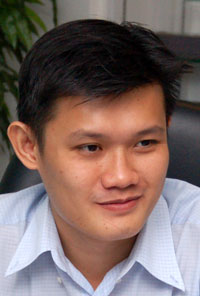
CFO Hau Khee Wee. Photo by Sim Kih
As such, foreign carmakers arrange for high profit margins to be made at the component-manufacturing level, instead of the car-assembly level.
Chinese-owned component makers do exist but they are relatively small, and tend to be engaged in producing less complicated parts.
One of these players could be attractive as a partner in a joint venture with China Kunda. The partner would benefit from China Kunda’s mould expertise and would be able to compete for higher-margin jobs in component manufacturing.
This arrangement suits China Kunda as it would need relatively little capex, compared to starting its own manufacturing operations. And China Kunda would gain access to the sales and distribution channels of the component manufacturer.
Read more about the company’s background and strategies in CHINA KUNDA breaks the mould with upgrades, expansion



 NextInsight
a hub for serious investors
NextInsight
a hub for serious investors
